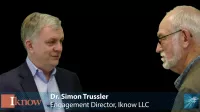Measuring the Business Value of KM
Every knowledge management (KM) initiative needs to showcase results and business impact. Unfortunately, many organizations have no agreed business measures for their KM programs, and focus on metrics reporting without actually understanding whether value is being realized. Getting it right demands linking programs and investments directly to business outcomes, and reporting to leadership in terms they can comprehend.
The Role of Metrics
Because knowledge is an intrinsic asset to organizations, it is difficult to put a value on it, or the impact of KM efforts. This is critical because KM efforts represent a real investment, spending money and/or resources on technologies, dedicated staff, and changes to business process.
It is not always clear how to show a linkage between these investments to business value, and it is often tricky. For example, a common-use case in consulting firms is improving the quality of the proposal process through knowledge and collaboration, with the goal of improving win rates on new bids. The question is how to isolate and understand the impact of KM initiatives on the win rate, given that there are so many variables (people, geography, training, competition) influencing this critical business measure. But business leaders want and need to know the impact nonetheless.
Most Organizations Fail
Because of this challenge, most organizations unfortunately revert to creating large binders full of “input” metrics, typically pulled from web analytics reporting tools. In our proposal example, this would include things such as searches and hits on the proposal repository, document downloads, click-thru rates, and so forth. These are often very detailed and impressive looking. And while these may provide much detailed information for the team managing the system day to day, this is not what business leadership wants to see. Leadership needs to know the impact of these investments on their win rates to understand how the investments can be improved over time.
This leads to frustration on the part of business leaders and CFOs, and it has the potential to prevent KM leaders from staying fully relevant to the business. And not understanding the business value created is also one reason why some organizations abandon their KM programs altogether.
Measuring Outcomes and Results
The key to overcoming this challenge is to focus reporting not on “inputs,” but on “outcomes.” Outcomes measures need to be communicated in business terms and aligned with the strategic objectives of the business unit. This isn’t always easy to do, and successful programs follow several common principles:
- Keep it simple. Pick no more than five high-level measures—focused on business outcomes, not KM inputs, and linked back to the business drivers/goals of your strategy. This is hard to do but is where you will structure the right dialogue with business leaders.
- Make it financial. Find creative ways to show tangible impact and turn it into financial value. For example, a recent KM initiative in a global consulting firm was able to save, on average, 40 hours of time to prepare each proposal. When multiplied by the value of staff time, these savings represented a very large financial benefit to the business, and was the genesis for leadership to roll out this same initiative elsewhere.
- Use your people. The best way to capture impact is by talking to your users. Users will know when new tools and resources are helping them do their jobs, save time, or win new work. Regular surveys and interviews of key staff are critical for acquiring feedback on KM initiatives. This will also help you obtain success stories and testimonials from notable users—another key to enhancing the dialogue with business leadership.
- Forget ROI. As tempting as it sounds, don’t attempt to calculate a holistic financial ROI calculation for KM. It is a losing battle and will cause a loss of focus.





